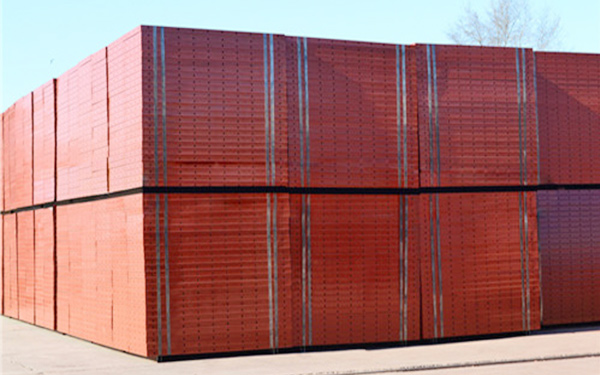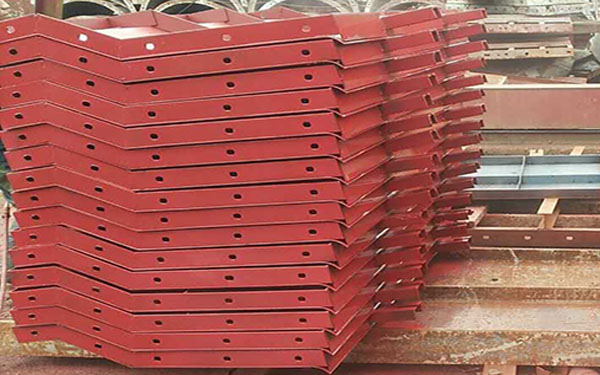Current position:
Home
News home
Industry News
Customized rental of construction steel formwork: How to prevent and deal with loose joints in steel formwork?
Customized rental of construction steel formwork: How to prevent and deal with loose joints in steel formwork?
source:Shandong Tianhong Heavy Industry Co., Ltd
Abstract:
Poor jointing of steel formwork can lead to leakage of grout during concrete pouring, resulting in quality problems such as surface honeycombing, pockmarks, and sand lines. In severe cases, it may affect the structural strength. The following are detailed methods for preventing and treating loose joints in steel formwork:
1、 Preventive measures
1. Optimization during the design phase
Reasonable segmentation: Design templates based on structural dimensions to reduce the number of joints and avoid joints located in stress concentration areas (such as corners).
Reserved tolerance: During template processing, reserve 1-2mm of joint allowance to prevent gaps caused by thermal expansion, contraction, or installation errors.
Use standard parts: Prioritize using standardized templates (such as P3015, P6015) to ensure seam alignment.
2. Material selection and processing
Template flatness: Check the flatness and straightness of the new template (error ≤ 1mm/m), and repair or eliminate deformed or corroded templates.
Sealing material: stick double-sided foam tape, rubber waterstop or sponge tape (3~5mm thick) at the seam to enhance the sealing.
Edge rib reinforcement: Weld reinforcement ribs to the edges of the template to prevent warping and deformation during assembly.
3. Construction process control
Installation sequence: Assemble layer by layer from bottom to top, use a ruler to check the flatness of the joints, and ensure that adjacent templates are tightly fitted.
Specification for connectors:
U-shaped card: spacing ≤ 300mm, staggered arrangement to avoid missing cards;
Bolt fixation: The spacing between through wall bolts or split bolts should be increased according to design requirements (especially at corners);
Fixture assistance: Use steel fixtures to temporarily reinforce the joints.
Corner treatment: The internal and external corner templates need to be locked with the flat template, and L-shaped angle steel or special connectors should be added at the joints.
4. Quality inspection
Joint inspection: Use a feeler gauge to check the joint gap (should be ≤ 1mm), and adjust or fill the sealing material in areas that exceed the tolerance.
Trial assembly acceptance: Conduct template trial assembly before formal pouring, simulate concrete lateral pressure testing, and observe whether there is any leakage of grout.
2、 On site handling measures for loose joints
1. Emergency treatment of slurry leakage
Temporary sealing: When leakage is found, immediately fill the gap with wooden wedges, cement mortar or quick setting gypsum, and apply tape on the outer layer to prevent expansion.
Reinforcing support: slant support or steel clamp shall be added at the leakage part to prevent the formwork from further displacement.
2. Quality repair after demoulding
Surface repair: For honeycomb and rough surfaces caused by grout leakage, after chiseling away loose concrete, repair with high-strength mortar or epoxy resin.
Structural reinforcement: If grout leakage causes exposed steel bars or section loss, grouting or carbon fiber reinforcement shall be carried out according to design requirements.
3、 Long term improvement suggestions
Template maintenance:
Clean the residual concrete at the joints after each demoulding, repair the deformed edges and ribs, and apply anti rust oil.
Process upgrade:
Using BIM technology to simulate template joint positions and optimize layout design;
Introduce new sealing materials (such as silicone sealant, polyurethane foam strip).
Personnel training:
Regularly provide template installation specification training to workers, with a focus on explaining joint processing techniques.
4、 Key points for seam processing in different scenarios
Key points of scene seam processing
Vertical joints of high-rise shear walls are reinforced with U-shaped clamps, and angle steel is added at corners
The inner and outer sides of the circular joint of the bridge pier column are double sealed with waterstops and bolts
Customized heteromorphic structures with heteromorphic templates to reduce seams, with partial use of wooden templates for transition
Paste 3mm thick double-sided adhesive tape at the joint of plain concrete to ensure that there are no traces after demoulding
summarize
The core solution to the problem of loose joints in steel formwork is "prevention first, treatment as a supplement":
Prevention: Reduce joint problems from the source by optimizing design, standardizing construction, and conducting strict inspections;
Handling: Quickly seal the leakage of grout, and repair it in a targeted manner after demoulding to avoid affecting the durability of the structure;
Improvement: Combining technological upgrades and personnel training to enhance the standardization level of template construction.
1. Optimization during the design phase
Reasonable segmentation: Design templates based on structural dimensions to reduce the number of joints and avoid joints located in stress concentration areas (such as corners).
Reserved tolerance: During template processing, reserve 1-2mm of joint allowance to prevent gaps caused by thermal expansion, contraction, or installation errors.
Use standard parts: Prioritize using standardized templates (such as P3015, P6015) to ensure seam alignment.
2. Material selection and processing
Template flatness: Check the flatness and straightness of the new template (error ≤ 1mm/m), and repair or eliminate deformed or corroded templates.
Sealing material: stick double-sided foam tape, rubber waterstop or sponge tape (3~5mm thick) at the seam to enhance the sealing.
Edge rib reinforcement: Weld reinforcement ribs to the edges of the template to prevent warping and deformation during assembly.
3. Construction process control
Installation sequence: Assemble layer by layer from bottom to top, use a ruler to check the flatness of the joints, and ensure that adjacent templates are tightly fitted.
Specification for connectors:
U-shaped card: spacing ≤ 300mm, staggered arrangement to avoid missing cards;
Bolt fixation: The spacing between through wall bolts or split bolts should be increased according to design requirements (especially at corners);
Fixture assistance: Use steel fixtures to temporarily reinforce the joints.
Corner treatment: The internal and external corner templates need to be locked with the flat template, and L-shaped angle steel or special connectors should be added at the joints.
4. Quality inspection
Joint inspection: Use a feeler gauge to check the joint gap (should be ≤ 1mm), and adjust or fill the sealing material in areas that exceed the tolerance.
Trial assembly acceptance: Conduct template trial assembly before formal pouring, simulate concrete lateral pressure testing, and observe whether there is any leakage of grout.
2、 On site handling measures for loose joints
1. Emergency treatment of slurry leakage
Temporary sealing: When leakage is found, immediately fill the gap with wooden wedges, cement mortar or quick setting gypsum, and apply tape on the outer layer to prevent expansion.
Reinforcing support: slant support or steel clamp shall be added at the leakage part to prevent the formwork from further displacement.
2. Quality repair after demoulding
Surface repair: For honeycomb and rough surfaces caused by grout leakage, after chiseling away loose concrete, repair with high-strength mortar or epoxy resin.
Structural reinforcement: If grout leakage causes exposed steel bars or section loss, grouting or carbon fiber reinforcement shall be carried out according to design requirements.
3、 Long term improvement suggestions
Template maintenance:
Clean the residual concrete at the joints after each demoulding, repair the deformed edges and ribs, and apply anti rust oil.
Process upgrade:
Using BIM technology to simulate template joint positions and optimize layout design;
Introduce new sealing materials (such as silicone sealant, polyurethane foam strip).
Personnel training:
Regularly provide template installation specification training to workers, with a focus on explaining joint processing techniques.
4、 Key points for seam processing in different scenarios
Key points of scene seam processing
Vertical joints of high-rise shear walls are reinforced with U-shaped clamps, and angle steel is added at corners
The inner and outer sides of the circular joint of the bridge pier column are double sealed with waterstops and bolts
Customized heteromorphic structures with heteromorphic templates to reduce seams, with partial use of wooden templates for transition
Paste 3mm thick double-sided adhesive tape at the joint of plain concrete to ensure that there are no traces after demoulding
summarize
The core solution to the problem of loose joints in steel formwork is "prevention first, treatment as a supplement":
Prevention: Reduce joint problems from the source by optimizing design, standardizing construction, and conducting strict inspections;
Handling: Quickly seal the leakage of grout, and repair it in a targeted manner after demoulding to avoid affecting the durability of the structure;
Improvement: Combining technological upgrades and personnel training to enhance the standardization level of template construction.
Disclaimer: The content provided on this website is for reference only (some information is sourced from the internet). The publication of content information is for the purpose of transmission and does not represent the views of this website. If the content involves copyright issues, please contact the website editor in a timely manner, and we will take appropriate measures to avoid unnecessary losses for both parties.
Related article
- Wholesale manufacturer of steel formwork rental: Analysis of design requirements for highway steel formwork
- Customization of steel formwork specifications: What are the installation steps for steel formwork? 双语对照 笔记
- Renting steel formwork: What is the price of steel formwork?
- How to calculate the bearing capacity of steel formwork for rental manufacturers of construction steel formwork?
- Bridge anti-collision guardrail steel formwork: What are the common methods for correcting steel formwork?
- Renting steel formwork manufacturers: How much does the material of steel formwork affect the price?
- Steel template manufacturers, wholesalers, and suppliers: What should be done if there are scratches on the surface of the template?
- Customized rental of construction steel formwork: How to ensure the installation accuracy of steel formwork?
- Supply from nearby steel formwork manufacturers: How to extend the service life of formwork in highly corrosive environments?
- Customized steel formwork manufacturers: How to avoid leakage of grout at the joints of the formwork?
- Processing custom steel formwork factory: About rust prevention treatment methods and precautions for steel formwork
- Nearby steel formwork manufacturers: What is the maintenance cycle for stainless steel formwork?
Hot article

- T梁模版
- Pulling out Mountains and Rivers for Win Win - Jining Tianli Employees Celebrate National Day Holiday with Tug of War Competition
- 力“拔”山兮,“河”作共赢——济宁天力员工欢度国庆假期之拔河比赛
- Pulling out Mountains and Rivers for Win Win - Jining Tianli Employees Celebrate National Day Holiday with Tug of War Competition
- Pulling out Mountains and Rivers for Win Win - Jining Tianli Employees Celebrate National Day Holiday with Tug of War Competition
- Pulling out Mountains and Rivers for Win Win - Jining Tianli Employees Celebrate National Day Holiday with Tug of War Competition
- Pulling out Mountains and Rivers for Win Win - Jining Tianli Employees Celebrate National Day Holiday with Tug of War Competition
Recommended article

Customized rental of steel formwork: What are the dimensions, specifications, and models of steel formwork?

Steel formwork manufacturer supply specifications: What are the applicable fields for steel formwork
- Customized rental of steel formwork: What are the dimensions, specifications, and models of steel formwork?
- Steel formwork manufacturer supply specifications: What are the applicable fields for steel formwork
- 力“拔”山兮,“河”作共赢——济宁天力员工欢度国庆假期之拔河比赛
- Pulling out Mountains and Rivers for Win Win - Jining Tianli Employees Celebrate National Day Holiday with Tug of War Competition
- Pulling out Mountains and Rivers for Win Win - Jining Tianli Employees Celebrate National Day Holiday with Tug of War Competition
- Pulling out Mountains and Rivers for Win Win - Jining Tianli Employees Celebrate National Day Holiday with Tug of War Competition
- Pulling out Mountains and Rivers for Win Win - Jining Tianli Employees Celebrate National Day Holiday with Tug of War Competition
- Pulling out Mountains and Rivers for Win Win - Jining Tianli Employees Celebrate National Day Holiday with Tug of War Competition



